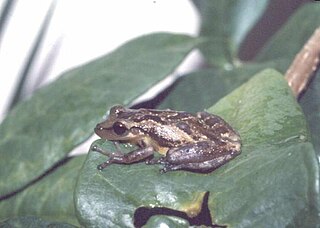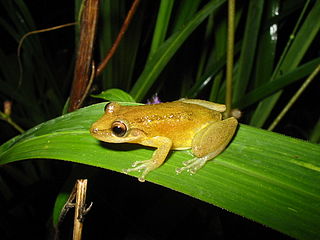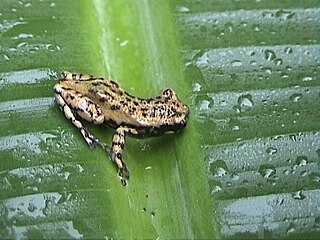
Scinax acuminatus is a species of frog in the family Hylidae. It is found in Argentina, Bolivia, Brazil, Paraguay, and possibly Uruguay. Its natural habitats are moist savanna, subtropical or tropical moist shrubland, subtropical or tropical seasonally wet or flooded lowland grassland, freshwater lakes, intermittent freshwater lakes, freshwater marshes, intermittent freshwater marshes, pastureland, rural gardens, heavily degraded former forest, ponds, and canals and ditches. It breeds in bodies of water. It is threatened by eventual habitat loss, but the population is currently fairly stable, as it adapts fairly well to human encroachment and development.

Scinax boulengeri is a species of frog in the family Hylidae. It is found in Colombia, Costa Rica, Nicaragua, Panama, and possibly Honduras. Its natural habitats are subtropical or tropical moist lowland forests, intermittent freshwater marshes, pastureland, plantations, rural gardens, and urban areas. It has been found as high as 600 meters above sea level.
Scinax caldarum is a species of frog in the family Hylidae. It is endemic to Brazil. Its natural habitats are subtropical or tropical seasonally wet or flooded lowland grassland, subtropical or tropical high-altitude grassland, freshwater marshes, intermittent freshwater marshes, pastureland, rural gardens, ponds, and canals and ditches. It is threatened by habitat loss.

Scinax crospedospilus is a species of frog in the family Hylidae. It is endemic to Brazil. Its natural habitats are subtropical or tropical moist shrubland, subtropical or tropical seasonally wet or flooded lowland grassland, subtropical or tropical high-altitude grassland, freshwater marshes, intermittent freshwater marshes, pastureland, heavily degraded former forest, ponds, and canals and ditches.

Scinax cuspidatus is a species of frog in the family Hylidae. It is endemic to Brazil. Its natural habitats are subtropical or tropical moist lowland forests, subtropical or tropical moist shrubland, subtropical or tropical dry lowland grassland, freshwater marshes, intermittent freshwater marshes, rocky areas, heavily degraded former forest, and ponds. It is threatened by habitat loss.
Scinax exiguus is a species of frog in the family Hylidae. It is found in the Gran Sabana of Venezuela and in the Roraima state of the adjacent northern Brazil, as far south as Boa Vista, Roraima. Common name Gran Sabana snouted treefrog has been coined for it.

Scinax funereus is a species of frog in the family Hylidae. It is found in Brazil, Ecuador, Peru, and possibly Bolivia. Its natural habitats are subtropical or tropical moist lowland forests, intermittent freshwater marshes, rural gardens, and heavily degraded former forest.

Scinax fuscomarginatus is a species of frog in the family Hylidae. It is found in northwestern Argentina, Paraguay, eastern Bolivia, southern, central, and eastern Brazil, and in scattered localities in the lowlands of eastern Venezuela and savannas of Guyana and southern Suriname as well as adjacent Brazil. As currently defined, it is one of the most widespread Neotropical frogs; the northernmost records refer to what was formerly recognized as Scinax trilineatus. Common name brown-bordered snouted treefrog has been coined for this species.

Scinax garbei is a species of frog in the family Hylidae. It is found in Bolivia, Brazil, Colombia, Ecuador, Peru, Venezuela, and possibly Guyana. Its natural habitats are subtropical or tropical moist lowland forests, subtropical or tropical swamps, rivers, intermittent freshwater marshes, plantations, rural gardens, heavily degraded former forest, and ponds.

Scinax granulatus is a species of frog in the family Hylidae. It is found in Argentina, Brazil, Paraguay, and Uruguay. Its natural habitats are temperate shrubland, subtropical or tropical moist shrubland, temperate grassland, subtropical or tropical seasonally wet or flooded lowland grassland, freshwater lakes, freshwater marshes, intermittent freshwater marshes, pastureland, plantations, rural gardens, urban areas, water storage areas, ponds, and canals and ditches.

Scinax hayii is a species of frog in the family Hylidae. It is endemic to Brazil. Its natural habitats are subtropical or tropical moist lowland forests, subtropical or tropical moist montane forests, rivers, freshwater marshes, intermittent freshwater marshes, pastureland, urban areas, heavily degraded former forest, and ponds.
Scinax ictericus is a species of frog in the family Hylidae. It is found in Colombia, Peru, possibly Bolivia, and possibly Brazil. Its natural habitats are subtropical or tropical moist lowland forests and intermittent freshwater marshes. It is threatened by habitat loss.
Scinax lindsayi is a species of frog in the family Hylidae. It is found in Brazil, Colombia, and possibly Venezuela. Its natural habitats are subtropical or tropical moist lowland forests and intermittent freshwater marshes. It is threatened by habitat loss.
Scinax maracaya is a species of frog in the family Hylidae. It is endemic to Brazil. Its natural habitats are moist savanna, freshwater marshes, and intermittent freshwater marshes. It is threatened by habitat loss.

The blue-headed snouted tree frog or Spix's snouted tree frog is a species of frog in the family Hylidae. It is found in Bolivia, Brazil, French Guiana, Guyana, Suriname, and Venezuela. Its natural habitats are subtropical or tropical moist lowland forests, moist savanna, intermittent freshwater marshes, pastureland, rural gardens, and heavily degraded former forest. It is threatened by habitat loss.
Scinax pedromedinae is a species of frog in the family Hylidae. It is found in the upper Amazon basin of eastern Peru, northern Bolivia, and western Brazil; its range might extent to extreme southeastern Colombia.

Scinax perereca is a species of frog in the family Hylidae. It is found in Brazil, Argentina, and Paraguay. Its natural habitats are subtropical or tropical moist lowland forests, freshwater marshes, intermittent freshwater marshes, heavily degraded former forest, ponds, and canals and ditches. It is threatened by habitat loss.

Julianus uruguayus is a species of frog in the family Hylidae. It is found in Argentina, Brazil, and Uruguay. Its natural habitats are moist savanna, subtropical or tropical seasonally wet or flooded lowland grassland, freshwater marshes, and intermittent freshwater marshes. It is threatened by habitat loss.

Scinax x-signatus is a species of frog in the family Hylidae. It is found in Brazil, the Guyanas, Venezuela and Colombia. Introduced populations exist on Guadeloupe and two nearby smaller islands, Marie Galante and La Désirade, and on Martinique. It may represent more than one species.
Scinax manriquei is a species of frogs in the family Hylidae. It was described in 2004 from Venezuela, the same year as Scinax flavidus was described from Colombia. They are now considered to be synonyms, with Scinax manriquei having the seniority over Scinax flavidus. The species thus defined occurs in the Andean footshills of both Colombia and Venezuela. It has been found in cloud forests as well as in a variety of disturbed habitats.














